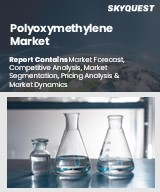
폴리옥시메틸렌 세계 시장 규모는 2023년에 58억 달러로 평가되었으며, 2024년 61억 7,000만 달러에서 2032년에는 101억 4,000만 달러로 성장하여 예측 기간(2025-2032년) 동안 CAGR 6.4%로 성장할 전망입니다.
전기 및 전자 분야에서 폴리옥시메틸렌(POM)의 보급은 주로 우수한 내열성, 절연성, 내구성에 기인합니다. 이 소재는 회로 기판, 스위치, 전기 하우징, 커넥터에 널리 사용되고 있으며, 열을 줄이고 수명을 연장하여 장비의 효율을 높입니다. 또한, POM은 비용 효율적인 부품의 대량 생산이 가능하기 때문에 제조업체의 수익률을 향상시킵니다. 자동차 업계에서는 차량 무게를 최소화하고, 연비를 최적화하고, 엄격한 배기가스 규제에 대응하기 위해 POM을 활용하는 제조업체가 증가하고 있습니다. 또한, 전기자동차 연구개발에 대한 투자가 활발해지면서 자동차 제조사들이 경량화 및 에너지 효율이 높은 솔루션 개발을 모색하고 있어 POM에 대한 수요가 증가하고 있습니다. 그 결과, POM은 전자 및 자동차 분야에서 필수 불가결한 소재가 되고 있습니다.
Global Polyoxymethylene Market size was valued at USD 5.8 billion in 2023 and is poised to grow from USD 6.17 billion in 2024 to USD 10.14 billion by 2032, growing at a CAGR of 6.4% during the forecast period (2025-2032).
The growing prevalence of polyoxymethylene (POM) in the electrical and electronics sector is primarily attributed to its impressive thermal resistance, insulation capabilities, and durability. This material is extensively utilized in circuit boards, switches, electrical housings, and connectors, which enhance appliance efficiency by reducing heat and prolonging lifespan. Moreover, POM facilitates cost-effective mass production of components, thus improving profit margins for manufacturers. In the automotive industry, manufacturers are increasingly leveraging POM to minimize vehicle weight, optimize fuel efficiency, and comply with stringent emissions regulations. Additionally, heightened investment in electric vehicle research and development is driving POM's demand as automakers seek to create lightweight, energy-efficient solutions. As a result, POM is becoming indispensable in both electronics and automotive applications.
Top-down and bottom-up approaches were used to estimate and validate the size of the Global Polyoxymethylene market and to estimate the size of various other dependent submarkets. The research methodology used to estimate the market size includes the following details: The key players in the market were identified through secondary research, and their market shares in the respective regions were determined through primary and secondary research. This entire procedure includes the study of the annual and financial reports of the top market players and extensive interviews for key insights from industry leaders such as CEOs, VPs, directors, and marketing executives. All percentage shares split, and breakdowns were determined using secondary sources and verified through Primary sources. All possible parameters that affect the markets covered in this research study have been accounted for, viewed in extensive detail, verified through primary research, and analyzed to get the final quantitative and qualitative data.
Global Polyoxymethylene Market Segments Analysis
Global Polyoxymethylene Market is segmented by Type, Application, Processing Method, Grade and region. Based on Type, the market is segmented into Homopolymer and Copolymer. Based on Application, the market is segmented into Automotive, Electrical and Electronics, Consumer Goods, Industrial Machinery and Medical and Healthcare. Based on Processing Method, the market is segmented into Injection Molding, Extrusion and Other Processing Methods. Based on Grade, the market is segmented into Standard Grade, High-Performance Grade and Specialty Grade. Based on region, the market is segmented into North America, Europe, Asia Pacific, Latin America and Middle East & Africa.
Driver of the Global Polyoxymethylene Market
The global polyoxymethylene (POM) market is primarily driven by the automotive industry, which is one of its largest consumers. The increasing integration of POM in various applications such as fuel system components, gear wheels, interior trims, and safety features underscores its significance. The industry's focus on lightweight materials is pivotal in enhancing fuel efficiency and minimizing carbon emissions, consequently propelling the demand for POM. Offering superior mechanical strength, low friction, and exceptional wear resistance compared to traditional metals, POM serves as an effective alternative for metal components. Furthermore, the growing shift towards electric vehicles (EVs) amplifies POM demand as manufacturers require robust, lightweight materials for critical parts like battery systems and structural connections.
Restraints in the Global Polyoxymethylene Market
The global Polyoxymethylene (POM) market faces significant challenges due to increasing governmental regulations aimed at reducing plastic waste. As POM is a non-biodegradable polymer, its role in plastic pollution has prompted various regions to impose restrictions and bans on certain plastic products. Initiatives like the European Union's Single-Use Plastics Directive are driving manufacturers to seek more sustainable, bio-based, or recyclable alternatives. Additionally, adhering to stringent chemical regulations, such as REACH (Registration, Evaluation, Authorization, and Restriction of Chemicals) in Europe, complicates the production process and raises costs for POM manufacturers, further hindering market growth and innovation.
Market Trends of the Global Polyoxymethylene Market
The Global Polyoxymethylene (POM) market is witnessing a significant trend driven by the integration of Artificial Intelligence (AI) in manufacturing and quality control processes. As manufacturers adopt AI technologies, they experience enhanced production efficiency, lower defect rates, and improved quality assurance. Predictive maintenance powered by AI allows for early detection of equipment failures, thereby minimizing downtime and operational costs. Additionally, automated defect detection utilizing advanced imaging and machine learning ensures high precision in POM components, especially in precision-critical sectors like automotive and electronics. As a result, major industry players are heavily investing in AI-driven systems to boost production yields and reduce material waste, enhancing profitability while meeting rising global demand.